Palm Trees Native to Florida (With Pictures) – Identification Guide

Palm trees native to Florida are an iconic feature of the Sunshine State. Native palm trees, with their tall, slender trunks and crowns or arching feather-like fronds, give the skyline of Florida’s tropical coast an exotic appeal. Also Florida has the perfect climate for growing palm trees—abundant rainfall, sandy soils, and year-long sunshine.
Many varieties of palm trees thrive in Florida. However, there are only 12 species of palm trees native to the Sunshine State. And the most common of these is the cabbage palm (Sabal palmetto)—also the state tree of Florida.
Native palm trees are key to Florida’s coastal ecosystems. Apart from creating picturesque scenes, native Florida palms are crucial for wildlife, offering shade and supporting microbial biodiversity in sandy soils. For example, the native royal palm (Roystonea regia) is home to many of Florida’s woodpeckers.
This article is an identification guide to the most common Florida native palm trees. Descriptions and pictures of identifying characteristics such as leaves, trunks, and fruit will help you identify different palm trees native to Florida.
What Palms Are Native to Florida
Twelve palm trees are indigenous to Florida. The most common native palms you will find in the southeastern state are the royal palm (Roystonea regia), cabbage palm (Sabal palmetto), and everglades palm (Acoelorrhaphe wrightii). In addition, the native dwarf palmetto (Sabal minor) is a small Florida palm tree ideal for landscaping coastal gardens.
Two palm trees endemic to Florida are the scrub palmetto (Sabal etonia) and the Miami palm tree (Sabal miamiensis). Unfortunately, the Miami palm tree is considered extinct in the natural landscape.
What Palms Are Not Native to Florida
Many of the palm trees growing in the Sunshine State are not native species. Common non-native palm trees in Florida include the popular coconut palm (Cocos nucifera), Canary Island date palm (Phoenix canariensis), Mexican fan palm (Washingtonia robusta), and the Chinese fan palm (Livistona chinensis).
It is thought that non-native palms arrived in Florida with settlers en route from Asia, Northern Africa, the South Pacific Islands, or Southern Europe to the Caribbean. Although many palms thrive in Florida’s climate, non-native varieties compete for space and nutrients and can become invasive.
Types of Palm Trees Native to Florida (With Pictures)
Florida is home to a wide variety of native palm trees. The tall, elegant, exotic trees are perfect for Florida’s hot and humid climate. Here are eleven varieties of palm trees native to the Sunshine State.
Cabbage Palm Tree (Sabal palmetto)
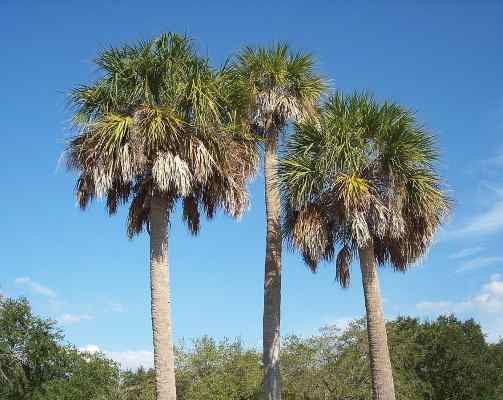
The cabbage palm is a tall hardy tree native to Florida that is suitable to be grown in coastal areas
The cabbage palm is a native Florida palm tree famed for its beauty and stately appearance. This Florida palm tree has a large rounded crown of fan-shaped fronds measuring up to 6 ft. (1.8 m) long. A characteristic of the cabbage palm is how the dead brown leaves dangle from the crown’s base.
The fast-growing native cabbage palm tree grows 40 to 65 ft. (12 – 20 m) tall. Its salt and wind tolerance makes it ideal for planting in coastal areas along the Atlantic Coast or the Gulf of Mexico. It thrives in USDA zones 8 to 11, meaning it thrives throughout Florida.
The state tree of Florida—Sabal palmetto–is common on roadsides and parks. Other identifying features of the palm tree are its creamy-white fragrant flowers, clusters of black palm fruits, and smooth gray trunk that turns shaggy about halfway to the top.
Other names for the cabbage palm include blue palmetto, cabbage tree, and palmetto palm. In addition to being Florida’s state tree, it’s also on the state flag of South Carolina.
Royal Palm Tree (Roystonea regia)
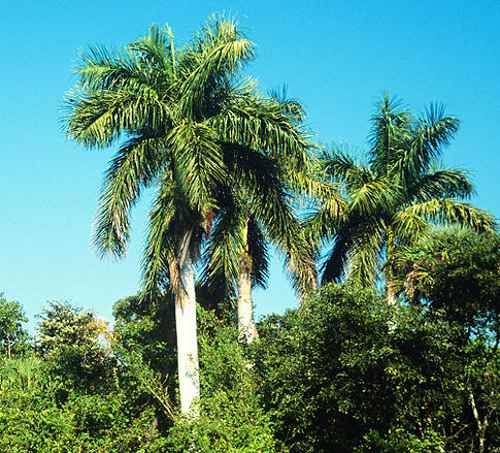
The native Florida royal palm is a tall ornamental tree suitable for the warmer parts of Florida
The royal palm tree is one of the most spectacular native palm trees in Florida. The huge royal palms are characterized by their smooth gray trunks, feather-like fronds, bright green crownshaft, and white flowers with pink anthers. The enormous palm leaves measure 13 ft. (4 m) long and self-clean from the tree.
Described as one of the world’s most beautiful palms, the ornamental royal palm grows 65 to 100 ft. (20 – 30 m) tall. Suitable for growing in USDA zones 10 and 11, the tall, slender palms are common for planting along streets, large drives, or property lines.
The Florida royal palm is also relatively tolerant of salty air, making it ideal for planting in coastal regions. In landscapes south of Lake Okeechobee, the royal palm is one of the most common tall palm trees you will see.
Saw Palmetto (Serenoa repens)
The small saw palmetto tree is suitable for limited spaces and small gardens
The saw palmetto is a palm tree native to Southeast Florida and characterized by blue-green fan-shaped fronds. The round palm leaves contain about 20 sharply-pointed leaflets lined with sharp spines or teeth. The leaves measure 3 to 6.5 ft. (1 – 2 m) long. And in spring, flowering stalks 3 ft. (1 m) long emerge with yellowish-white fragrant flowers.
Saw palmetto is a small palm tree, growing 5 to 10 ft. (1.5 – 3 m) tall and wide. It has shrub-like growth and often forms multi-stemmed thickets in the Florida landscape. Cold-hardy in USDA zones 8 to 11, it’s suitable as a landscaping plant throughout the southeast.
The bushy palm tree has several landscape uses, including attracting pollinators, producing berries, and evergreen foliage. Additionally, its sharp spiky foliage makes it ideal as a security barrier, foundation planting, or privacy hedge.
Buccaneer Palm (Pseudophoenix sargentii)
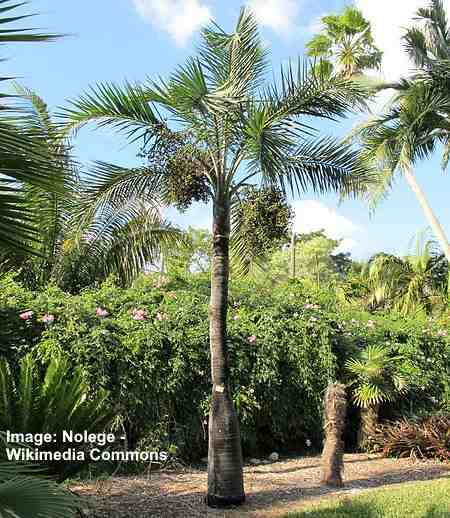
Buccaneer palm is medium sized tree which is slow growing and cold sensitive
Native to Southern Florida, the buccaneer palm is a medium sized palm tree with large arching feather-like fronds. Identifying features of the buccaneer palm are its clusters of small yellow flowers, red berry-like fruits, and smooth gray trunk with rings around it. Unlike many native palm trees, this species lacks a distinct crownshaft.
The slow-growing Florida palm can grow up to 26 ft. (8 m) tall. Its huge arching fronds grow 10 ft. (3 m) long. The drought-tolerant, sun-loving palm tree is adaptable to various soil types. The red berries on the palm also give it the name cherry palm or Sargent’s cherry palm.
The small buccaneer palm is ideal for growing in compact gardens in South Florida. The palm thrives in USDA zones 10 and 11 and is tolerant of salty air and the occasional flooding.
Florida Silver Palm (Coccothrinax argentata)
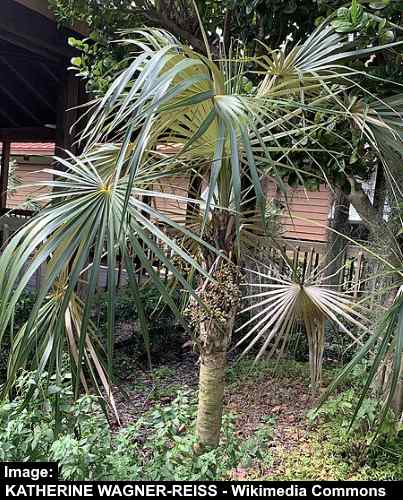
The small native Florida silver palm is a slow growing tree, making it a great choice for small spaces
The Florida silver palm is an attractive, tall, slender, evergreen palm tree native to the southern tip of Florida. The silver palm is characterized by its deeply divided palmate blue-green leaves, clusters of fragrant, creamy-white flowers, and small black summer fruits. The palm’s leaves measure 2 ft. (0.6 m) across.
The Florida silver palm thrives in USDA zones 10 and 11 in full sun and moist, well-drained soil. The small palm tree grows 5 to 20 ft. (1.5 – 6 m) tall and 5 ft. (1.5 m) wide. The slow-growing palm tree has a slender stature, making it perfect for growing in sunny, compact landscapes.
Other identifying characteristics of the Florida silver palm are its fan-shaped leaves, bluish-green leaflets with silvery undersides, and clusters of purplish-black berries. In addition, its tolerance of salt makes the palm an ideal landscaping tree for coastal locations.
Everglades Palm Tree (Acoelorrhaphe wrightii)
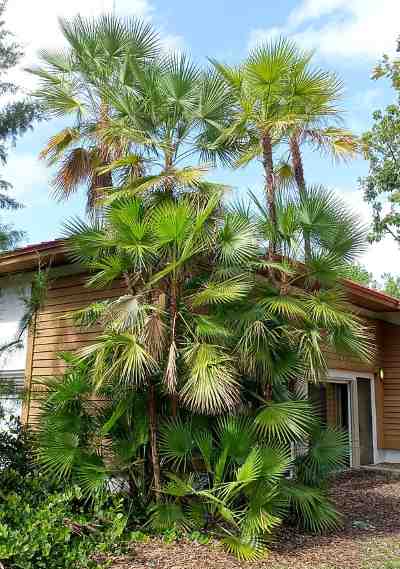
The everglades palm is a small to medium sized tree with fanning fronds
The everglades palm is an attractive multi-stemmed tree with large fan-shaped leaves on the ends of long, arching, spiny petioles. This ornamental palm tree has slender, shaggy trunks coated in fibrous matting. Its leaves are round and consist of stiff leaflets in a fan shape. The flowering palm has large clusters of fragrant flowers up to 3 ft. (1 m) long.
As its common name suggests, the everglades palm tree is native to the swampy areas of Southern Florida. Also called the Paurotis palm, this palm tree is ideal in a humid landscape, planted near ponds in coastal gardens, or in the ground with poorly-draining soil.
Suitable for full sun in USDA zones 10 and 11, the swamp-loving palm grows 20 to 30 ft. (6 – 9 m) tall and up to 25 ft. (7.5 m) wide. To increase its ornamental value in the landscape, you can remove the branches that emerge from the ground around the trunk.
Needle Palm (Rhapidophyllum hystrix)
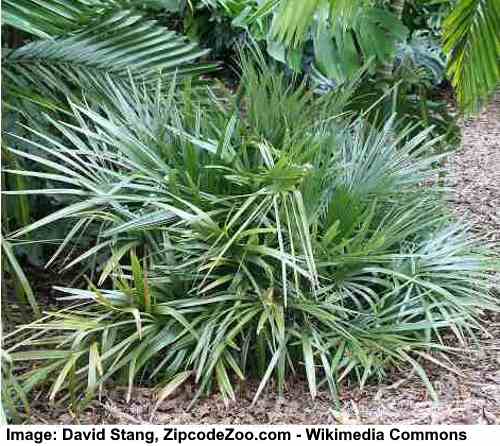
The needle palm is cold hardy small tree and can grow as a miniature patio palm
The needle palm is a cold-hardy evergreen tree with large, lustrous, dark green palmate leaves. The shrub-like, low-growing palm has a short, thick trunk with large leaves featuring strap-like pointed leaflets 3 ft. (1 m) long. Additionally, dense clusters of creamy-white flowers give way to reddish-brown fruits.
The needle palm tree grows 3 to 6 ft. (1 – 1.8 m) tall. This Florida palm tree is unusual because it thrives just as well in the shade as in the full sun. It is also cold-hardy to 5°F (-15°C) in USDA zones 6 to 10. This makes it ideal for planting throughout Florida, apart from the Florida Keys.
The suckering palm plant has many uses in a southern landscape. For example, you can plant it as a foundation plant, a low-growing informal screen, or to add a textural accent. In addition, its dense foliage and spiky, needle-like leaves are ideal for adding security around a property line.
Related reading: Palms trees to grow in Texas.
Florida Thatch Palm Tree (Thrinax radiata)
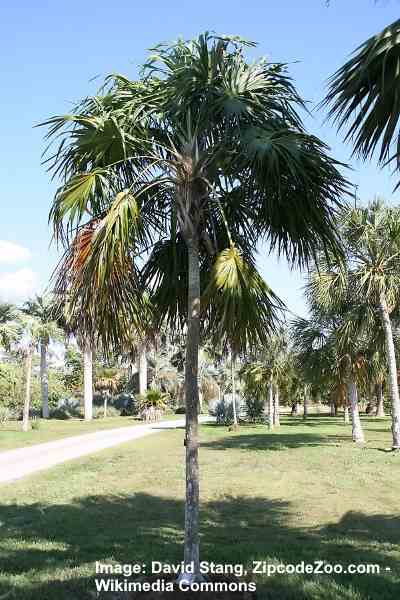
The Florida thatch palm tree is grown in South Florida and is identified by its skinny trunk
The Florida thatch palm is a popular palm tree in the southeastern United States. The thatch palm is characterized by its slender, vertical trunk, a spiky canopy of fan-shaped palmate leaves, and long dangling white flower clusters.
The Florida thatch palm is a slow-growing palm, averaging a growth rate of 6” (15 cm) per year. The palm tree matures at 20 to 30 ft. (3 – 9 m) tall. This palm tree species is easily identified due to its slender gray, typically rough trunk. Usually, 12 to 20 palmate fronds make up the shaggy rounded crown.
This native Florida palm tree is mostly found in coastal scrub areas and pinelands in South Florida. Landscape uses in USDA zones 10 and 11 for the Florida thatch palm include a specimen tree in a compact garden, a container plant, or adding greenery to coastal gardens.
Key Thatch Palm (Leucothrinax morrisii)
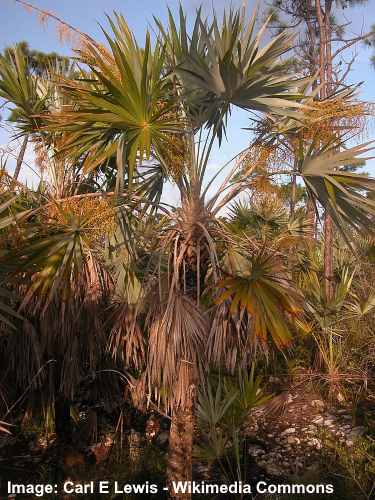
The small key thatch palm is native to the Florida Keys and is slow growing
The key thatch palm is a small palm tree native to Florida and blooms throughout the year. This slow-growing, small palm tree has a slender trunk and upright, spreading crown consisting of large palmate, fan-shaped fronds. The palm leaves are bright green with silver undersides, creating a shimmering effect in the breeze.
The key thatch palm tree grows 20 to 35 ft. (6 – 10 m) tall and 8 to 12 ft. (2.4 – 3.6 m) wide. The large leaves consist of slender, pointed leaflets measuring 18” to 24” (45 – 60 cm) long. When in bloom in spring and summer, the tree produces clusters of yellowish-white flowers on arching stalks 3 to 5 ft. (1 – 1.5 m) long.
The key thatch palm tree is a popular landscaping tree for gardens in Southern Florida. The eye-catching palm looks attractive as a specimen tree or accent plant to an entranceway. It also grows well in a patio container due to its slow growth rate.
Scrub Palmetto Palm Tree (Sabal etonia)
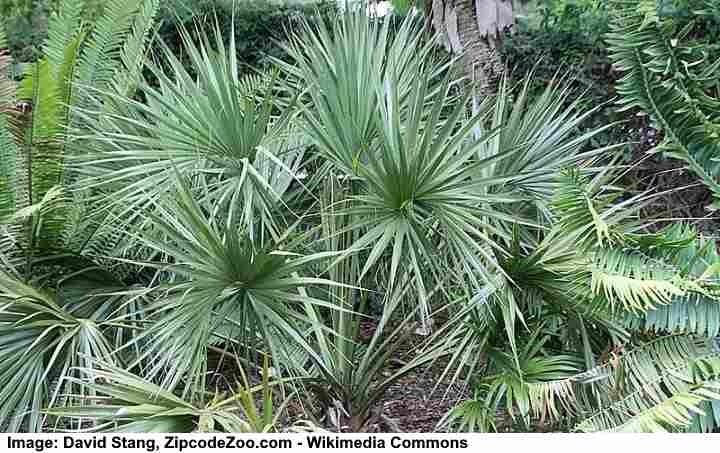
Scrub palmetto is a small shrub-like palm native to Florida and is cold hardy
The scrub palmetto palm tree is a small, shrub-like plant with leaf petioles emerging directly from the ground. The identifying features of this plan tree are its fan-shaped leaves, clusters of small white flowers, and brown or black drupes. The large palmate leaves grow 3 ft. (1 m) across and up to 4 ft. (1.2 m) tall.
The shrubby scrub palmetto palm spreads 4 to 5 ft. (1.2 – 1.5 m) wide. Thriving in USDA zones 8 through 11, it grows easily in dry, sandy soils. Thanks to its tough, hardy nature, the scrub palmetto palm is ideal for garden landscaping throughout the Sunshine State.
The scrub palmetto palm thrives in full sun or partial shade. However, due to its intolerance of salt air, it is best to plant the palm tree away from coastal areas. In addition to growing as a specimen plant, you can let the palm spread to create evergreen ground cover. You can also plant in mass plantings to add texture to an evergreen landscape.
Dwarf Palmetto (Sabal minor)
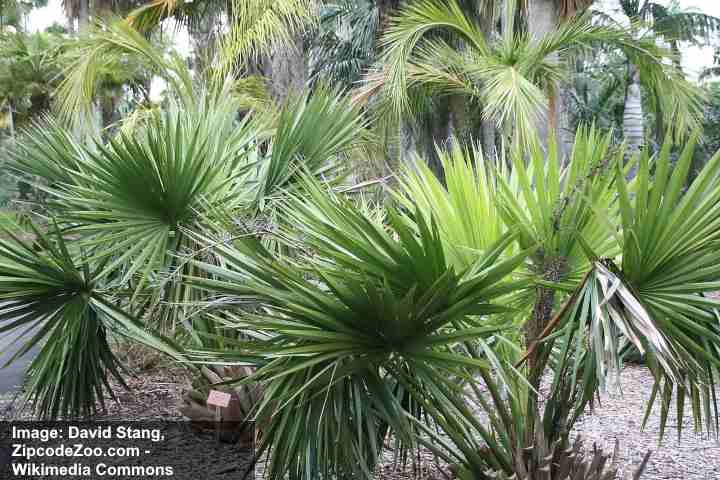
Dwarf palmetto can be found in many habitats and is a cold hardy small palm
Dwarf palmetto is one of the hardiest palms to grow in a Florida landscape. Like the scrub palmetto, this dwarf palm tree has leaf stems emerging from the ground. The fan-shaped green leaves with pointed, linear leaflets grow up to 3 ft. (1 m) in diameter. These grow on the end of spineless petioles growing in clumps of four to ten leaves.
The ornamental dwarf palmetto grows 4 to 6 ft. (1.2 – 1.8 m) tall and wide. In USDA zones 7 to 10, the native palm performs best in full sun or partial shade. In addition to its attractive foliage, the palm blooms with strongly fragrant clusters of creamy-white flowers followed by dark brown to black berry-like drupes.
Due to its low-growing nature and lack of trunk, the dwarf palmetto has several landscaping uses. For example, you can use it as a textural accent, foundation plant, or ground cover for shaded areas of your garden where there is poor drainage.
Discover the best small palm trees to grow in Florida.
Related articles:
